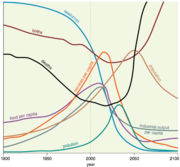Limits To Growth: Quick Web Bibliography
From enfascination
| Line 6: | Line 6: | ||
[[Image:System Dynamics Model.gif|thumb| Here is what the visualizations of system dynamic models tend to look like (they are just numerical integrations of systems of differential equations)]] | [[Image:System Dynamics Model.gif|thumb| Here is what the visualizations of system dynamic models tend to look like (they are just numerical integrations of systems of differential equations)]] | ||
| − | Limits to Growth is controversial, and not regarded very highly. It is very easy to call it names, and it has been called a lot of names. But its predictions were responsible, and they are bearing out. | + | Limits to Growth is controversial, and not regarded very highly. It is very easy to call it names, and it has been called a lot of names. But its predictions were responsible, and they are bearing out. For the (increasingly near) future it predicts a sharp decline in world's human population––in the first half of the twenty-first century. It proposes that the only way to prevent that is to make major changes at least thirty years ahead (so, say, twenty years ago). |
Read the books[http://www.amazon.com/exec/obidos/search-handle-url/index%3Dblended%26field-keywords%3Dlimits%20to%20growth] and you'll see how conservative their estimates were. They published a thirty year retrospective ten years ago and got a little attention. They noted that most of the predictions were still too soon to call, but that trends were in line with their most reasonable estimates. The books constantly compare and contrast best-case, worst-case and expected parameter settings. This makes it really hard to dismiss, that even their incredibly optimistic, unrealistic number pose the same dynamics (ultimate decline), but merely move the point of inflection back to the second half of the 21st century. | Read the books[http://www.amazon.com/exec/obidos/search-handle-url/index%3Dblended%26field-keywords%3Dlimits%20to%20growth] and you'll see how conservative their estimates were. They published a thirty year retrospective ten years ago and got a little attention. They noted that most of the predictions were still too soon to call, but that trends were in line with their most reasonable estimates. The books constantly compare and contrast best-case, worst-case and expected parameter settings. This makes it really hard to dismiss, that even their incredibly optimistic, unrealistic number pose the same dynamics (ultimate decline), but merely move the point of inflection back to the second half of the 21st century. | ||
Latest revision as of 17:56, 6 July 2010
Limits to Growth is a model of world development that was published in the 1970s. It linked a number of Earth-scale macroeconomic and macropolitical observables into tunable differential equations, and made a number of predictions for the state of the earth sort of between 2010 and 2050.
The main name behind it is Donella "Donna" Meadows. She studied "system dynamics" under Jay Forrester. Here is one of her coolest essays: Places to Intervene in a System. If you follow one link, follow that one.
Limits to Growth is controversial, and not regarded very highly. It is very easy to call it names, and it has been called a lot of names. But its predictions were responsible, and they are bearing out. For the (increasingly near) future it predicts a sharp decline in world's human population––in the first half of the twenty-first century. It proposes that the only way to prevent that is to make major changes at least thirty years ahead (so, say, twenty years ago).
Read the books[1] and you'll see how conservative their estimates were. They published a thirty year retrospective ten years ago and got a little attention. They noted that most of the predictions were still too soon to call, but that trends were in line with their most reasonable estimates. The books constantly compare and contrast best-case, worst-case and expected parameter settings. This makes it really hard to dismiss, that even their incredibly optimistic, unrealistic number pose the same dynamics (ultimate decline), but merely move the point of inflection back to the second half of the 21st century.
Here are some links I collected, because I wanted to get caught up:
- http://www.mnforsustain.org/meadows_limits_to_growth_30_year_update_2004.htm
- http://www.theoildrum.com/node/3551
- http://scienceblogs.com/corpuscallosum/2009/04/malthus_was_right.php
- http://www.mnforsustain.org/meadows_limits_to_growth_30_year_update_2004.htm
Oh, while searching, I found this excellent climate change news feed and archive: http://www.climatechangenews.org

